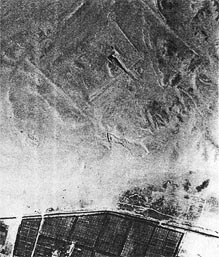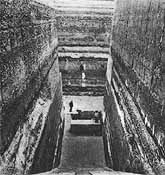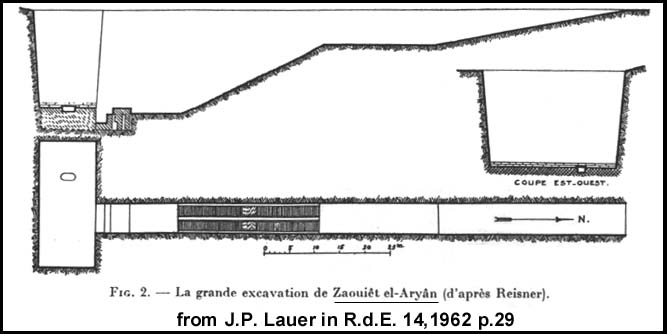|
|
|
|
NEBKARA, NEFERKA(RA)
Almost nothing is known of Nebkara/Neferka(ra): these names, rather common later in the Old Kingdom, are found in the new Kingdom king-list.
Neferkara is the 19th name in the Abydos King-list (between Sedjes and Snofru), whereas a 'Neferkara' on the Saqqara king-list (8th name) is placed in the Second dynasty (between Senedj and Neferkaseker). The same Saqqara list provides a Nebkara as the name of Huni's predecessor, late 3rd dynasty. The Turin Canon doesn't preserve any of these names.
There is a possibility (cf. D. Wildung, Die Rolle, 1969, 57) that Nebkara was a later OK or NK ("solar"-) transformation of the name of Nebka. The chronological position of Nebka as Dynasty III foundator is still debated (most recent studies set Nebka's reign in the second half of the dynasty). The identification of Nebka with a king known by his serekh/Horus-name is an unsolved question too (see Sanakht/Nebka page).
It has been debated for long time on the reading of the hieratic name in the Zawiyet el Aryan cartouches (cfr bibl. below); it has been proposed to read it Nefer-ka, Neb-ka (falcon on standard), A-Ka, Ba-Ka, Bik-Ka, Shena-ka, Seth-Ka.
See in particular N. Swelim 'Some Problems..., 1983': this author provides a lot of data on these names; he thought that Nebkara was the ambitious IIIrd Dynasty king who began the construction of the nowadays so called "Unfinished Pyramid" at Zawyiet el Aryan, whereas Neferka "seems to have completed the burial chamber of (Meidum) Mastaba 17 for the reburial of Nebkara and filled the trench and pit of the Unfinished Pyramid in the style of architecture that would have pleased Nebkara" (Swelim, Some Problems, 80); according to the same author, the bones found by Wainwright in Meydum Mastaba 17 burial chamber could have been those of Nebkara (op. cit., 97, 166); the body appeared to have been defleshed, the eyes torn out and orbits filled by paste balls, the penis and limbs cut off and bandaged separately. Also wooden model insignia (mace and crooks) were found in the chamber (Meydum p. 13 ff and plate XI).
With such a few data and old discoveries, it is easy to get lost into speculative hypothesis.
To further confuse the ideas, the inscriptions which Barsanti found on the site of the Northern Unfinished pyramid of Zawiyet el Aryan name more royal (?) names: in fig. 15 Nebtawy Nebkara, in fig. 35 Neferka (cf. the mid-Second Dynasty king name, written with the identical peculiarity of the oval shaped hands as in the KA-sign of Nebkara scarab in Petrie, op.cit. below) and, in fig. 55, an unknown Neb Hedjet Nwb (ty); Nabil Swelim considers this latter to be a "second name of (Shenaka) Neferka" (Swelim, The Brick Pyramid at abu Rawash, 86).
Kaplony (cfr. below) advanced that Neb-Hedjet-Nwb could have been the Horus name of H(w), last king of the dynasty (Huni).
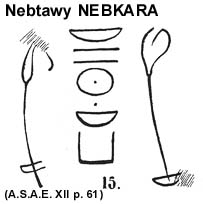
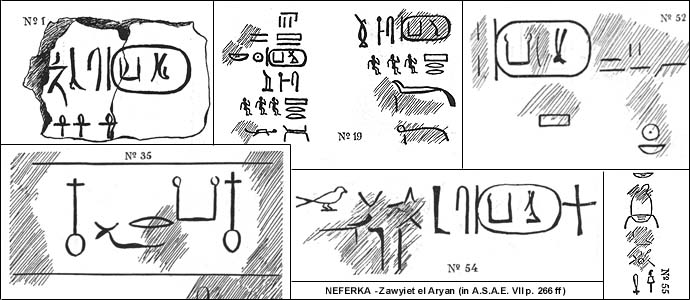
We have to remark that a large part of the -nonetheless precious and brilliant- study of Nabil Swelim on the Third Dynasty (op.cit. chap.3) was aimed to deny Lauer's datation of the Zawyiet el Aryan Unfinished pyramid to the fourth dynasty. The monument that the egyptian author ascribes to the IIIrd dynasty is made object of a detailed analysis which often invalidates the points which J.P. Lauer had taken as indicators of a IVth dynasty date.
It is hard to resume 55 pages of text but the summary by the same author (op. cit. p.175-6) can be here cited:
Djedefra's Abu Roash pyramid and Nebkara's at Zawyiet el Aryan have similar substructures; this because the former IVth dyn. king intended to copy IIIrd dyn. substructures; the complex around Zawyiet unfinished pyramid had no structure typical of the IVth dynasty complexes, but an enclosure wall (IIIrd dyn. characteristic) seems that would have been accomplished.
Extensive use of granite, a material already used from the thinite period, was responsible for the delay in construction: this led the followers to use limestone until a perfect mastery of masonry had been reached (Khwfw). The blocks size and weight is not out of the IIIrd dynasty builders' possibilities: at Meydum (Mastaba 17, dating to the end of IIIrd dyn.), larger blocks were used.
The sunken sarcophagus was in a transitional phase and even at the time of Djedefra and Khaefra not all the sarcophagi were sunken (Khwfw's,or Menkaura's main one that was sunken but at sea- with the ship that was bringing it to the British Museum).
Finally the mortar used, which Lauer thought to be of a precisely burnt quality, wasn't unknown before Snofrw as stated by the french scholar for an identical quality was recovered from the famous alabaster sarcophagus of IIIrd dyn. king Sekhemhet.
Therefore NEFERKA would have been a successor of NEBKARA and predecessor of HUNI.
Swelim also advanced that the Layer Pyramid of Zawyiet el Aryan was built by Neferka and the stone bowls of Khaba found in Z-500, north of the layer pyramid, could have been gifts or gathered antiquities like those from dynasty I found in the Step Pyramid complex.
Other hypotheses on these ephemeral kings' names are in Kaplony (R.A.R. I, 1977 p. 146-155; cfr. table in my Third dyn. page) who (op. cit., 154) proposes to identify Horus Za with njswt-bity Wr-Za-Khnwm (IAF I, 380, 468, 611) as Djoser's father and predecessor (interregnum of 2 years and 23 days); Horus Nekhet-za (Sanakht) with Hor Tehenwy Nwb (IAF III, n. 806) and njswt-bity Nebka (Ra), follower of Sekhemkhet and predecessor of Khaba - Netjer Nwb - njswt-bity Shenaka (Zawiyet el Aryan inscr.); finally the last (6th) king of the dynasaty would be Horus Neb Hedjet = Zawiyet el Aryan's Neb Hedjet Nwb who would be njswt-bity H(w) (Huni). P. Kaplony (op.cit.) pointed out that hwdjefa may reflect the same king-lists compilers' indecision in interpreting the name ?-ka.
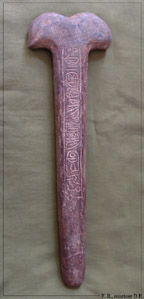
 UPDATE (8/2006): A new attestation of Nebkara's name is found on an object which has been recently, kindly shown me in photo by the owner, Mr. David Hafer. It is a polished stone implement shaped as a pesesh-kef knife (29,5cm tot. length), with a vertical inscription (16cm) which runs: "The lord of the gods of the Two Lands (Wa-s-r-k-n) has made as a monument to his (fore)father, (Neb-Ka-Ra), true of voice". Both the cartouches have a flat oval base with vertical strokes inside (Nebkara's one is indeed halfway between a cartouche and a serekh); the name of the dedicating king should be one of the 22-23 dynasty kings "Osorkon", although it is written with the s instead of the Za sign. I can't tell if this object/inscription is genuine (i.e. of Late Period) or instead a forgery (eventually based on another piece's inscription). In any case we have a further attestation of Nebkara's name, nearly two millennia after the supposed age of Nebkara's reign. This king, little more than a name to us, seems to have been a well known figure in antiquity, and in some instance it appears to have been regarded as a mythical ancestor or nonetheless as a ruler worthy of honors and praise by his distant successors (same case as for Menes?). I wonder about the original reason for such a glory and fame.
UPDATE (8/2006): A new attestation of Nebkara's name is found on an object which has been recently, kindly shown me in photo by the owner, Mr. David Hafer. It is a polished stone implement shaped as a pesesh-kef knife (29,5cm tot. length), with a vertical inscription (16cm) which runs: "The lord of the gods of the Two Lands (Wa-s-r-k-n) has made as a monument to his (fore)father, (Neb-Ka-Ra), true of voice". Both the cartouches have a flat oval base with vertical strokes inside (Nebkara's one is indeed halfway between a cartouche and a serekh); the name of the dedicating king should be one of the 22-23 dynasty kings "Osorkon", although it is written with the s instead of the Za sign. I can't tell if this object/inscription is genuine (i.e. of Late Period) or instead a forgery (eventually based on another piece's inscription). In any case we have a further attestation of Nebkara's name, nearly two millennia after the supposed age of Nebkara's reign. This king, little more than a name to us, seems to have been a well known figure in antiquity, and in some instance it appears to have been regarded as a mythical ancestor or nonetheless as a ruler worthy of honors and praise by his distant successors (same case as for Menes?). I wonder about the original reason for such a glory and fame.
NOTE: I have been informed of similar PsS-Kf with cartouche names of Middle Kingdom pharaohs, Sesostri and Nebhepetra (Monthuhotep II). Thus the piece in object might be a later copy of MK originals (this would explain the epigraphic variations) and the names of Osorkon and Nebkara should be substituted with Senusert and Nebhepetra.

- I wish to thank Mr. David Hafer for sending me photos and infos about the inscribed Pesesh-kef stone tool which he bought from an antiquities dealer in 1999; Mr. ??? for the info about MK adzes with Sesostri and Nebhepetra's names.
- A. Barsanti excavations were summarized in ASAE VII, VIII, XII, but see also the
bibliography in Swelim (Some Problems, 1983, ch. III).
- For the reading of the hieratic cartouche-name in the inscriptions from
Zawyiet el Aryan see Swelim (op.cit.), A. Dodson, in ZAS 108, 171; id., DE
3, 21-3; J.P. Lauer, in RdE 14, 1962, 21-36; J. Cerny, in MDAIK 16, 1958, 25-9; D. Wildung, Die Rolle, 1969, 57, 212.
- Further old attestations of the name of Nebkara are in Gauthier (Le Livre
des Rois I, p. 53-54) and reported by Swelim (cit).
- Also cf. for Nibkara and Neferka(ra)
R. Weill, La IIe et la IIIe dynasties, 1908, 434-437 (Zawiyet inscr.); id., Ire Dynastie II, 1961, 163-7 (king-lists).
- F. Petrie's 'Scarabs and Cylinders...', 1917, shows (plate 8) four scarabs
with Nebkara's name (cf. above). In the first one the ka-sign has circular hands. The last one is accompanied by another cartouche with a name Nefer-ra (see fig. above).
- For the PsS-Kf flint implement (later used to perform the ritual of the 'Opening of the Mouth'), cf. J.E. Quibell, ASAE 2, 1901, 131-132, pl. I; W. Helck, MDAIK 22, 1967, 38f.; E. Graefe, JEA 57, 1971, 203; R. Friedman, Nekhen News 16, 2004, 8-9, color photo p. 16 (fishtail knife and handle from HK43, burial 412); T. Hikade, Nekhen News 16, 2004, 9-10 (fish-tail knives in predynastic Egypt); A.M. Roth, in JEA 78, 1992 and JEA 79, 1993 ('Opening of the Mouth' and associated pss-kf knife, ntrwj blades and adzes).
© FRANCESCO RAFFAELE
